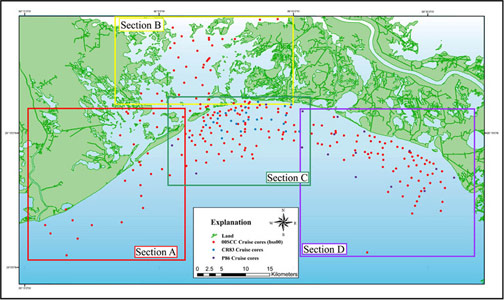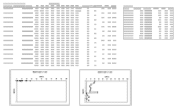 |
|
|
||||
| U.S. Geological Survey Data Series 344 |
|
Grain-Size Data Information defining the grain-size data and explaining how the data were obtained and processed is available in the Methods section under Grain-size Analysis. The downloadable Microsoft Excel spreadsheet (XLS) files contain a grain-size table with data on each of the downcore subsamples listed under the Sample ID. The following table (click on table below for larger image) describes the attribute columns on the spreadsheets:1 Sample identification/interval 2. Sample depth downcore in feet and meters (if available). 3. A series of columns representing the percent amount of the sample finer than the entire sample (ranging from 5 to 95% in mm and phi). 4. The moments about each subsample: mean (Inman, 1952), standard deviation (phi units), and percent sand, silt, and clay in each subsample. 5. A chart table that represents the sample name, depth, and percent sand, silt, and clay. Below both tables are one or two charts displaying depth in feet or meters (if available) and percent sand. Penetrometer Data Information defining the penetrometer data and explaining how the data were obtained is available in the Methods section under Penetrometer. The Penetrometer data consist of a graph that represents core penetration into the sediments over time. The linked files in the Core Data Table are available as Microsoft Excel spreadsheets. These files contain the actual data of recorded depth values (feet) in the first column and time values (seconds) in the second column, and the graph of depth versus time. Accessing the Data To access the data for each core simply click on the Study Area Map (right) and then navigate to the section that contains the desired core. Right-click (to open page in a new window) on a core or core label to activate a table that contains links to specific data sets for each core. The grain-size and penetrometer data for each cruise are presented in the data table on the Core Data Table page. The table contains a two column entitled (1) Grain-Size, and (2) Penetrometer Data, both columns each contain cores with a thumbnail preview file and links to XLS files. Note: There were no Grain Size or Penetrometer Data available for the 83CR cruise. |

Click on the Study Area Map above to open an enlarged map version. The enlarged map contains core locations that are linked to Vibracore Description Sheets, Interpreted Core Classification Profiles, Photographs, and Grain-Size and Penetrometer Data. |

Penetrometer Data

The grain-size data presented in the excel graphs were adapted from grain-size data found in Suter, and others (1991). The sand percents reported were both observed and analyzed. Grain-size analysis for these cores was random and sometimes infrequent. The data presented in the table are the sample ID, depth downcore, the grain size in phi (analyzed data only), and sand percents (observed and analyzed). The analyzed sand percents are presented with the phi size of the sample in each table above or to left of the graph. Data were not available for cores P86_02, P86_03, P86_04, P86_06, P86_08, P86_09, P86_10, P86_13, and P86_18.
A Beckman Coulter LS 200 laser diffractometer was used to analyze sediment grain size for cruise 00SCC, consisting of the bss cores. The grain-size data presented in the Excel table include the sample ID, depth downcore, the grain-size in phi and mm, and sand, silt, and clay percents. The sand percent is graphed against depth downcore. The data were obtained through collaboration with the University of New Orleans Coastal Research Lab. Bss cores that were not analyzed were bss00_001 - bss00_031, bss00_107 - bss00_113, bss00_123 - bss00_124, bss00_126 - bss00_127, bss00_149 - bss00_154, bss00_157 - bss00_159, and bss00_162.
Penetrometer data were obtained on site at time of vibracore collection; refer to Methods for more information. The data files can be opened in Excel. The thumbnail is a snapshot representation of the of graphed Excel surface depth (feet) versus elapsed time graph from start of vibration to refusal (seconds). For unknown reasons, perhaps equipment failure, some bss cores for cruise 00SCC00 are not presented, due to no available data. Penetrometer data do not exist for cores bss00_001 - bss00_008, bss00_020, bss00_025 - bss00_027, bss00_033, bss00_066, bss00_086B - bss00_089, bss00_095, bss00_114B, bss00_119 - bss00_121, bss00_124 - bss00_141, bss00_149 - bss00_154, bss00_157 - bss00_159, and bss00_162.